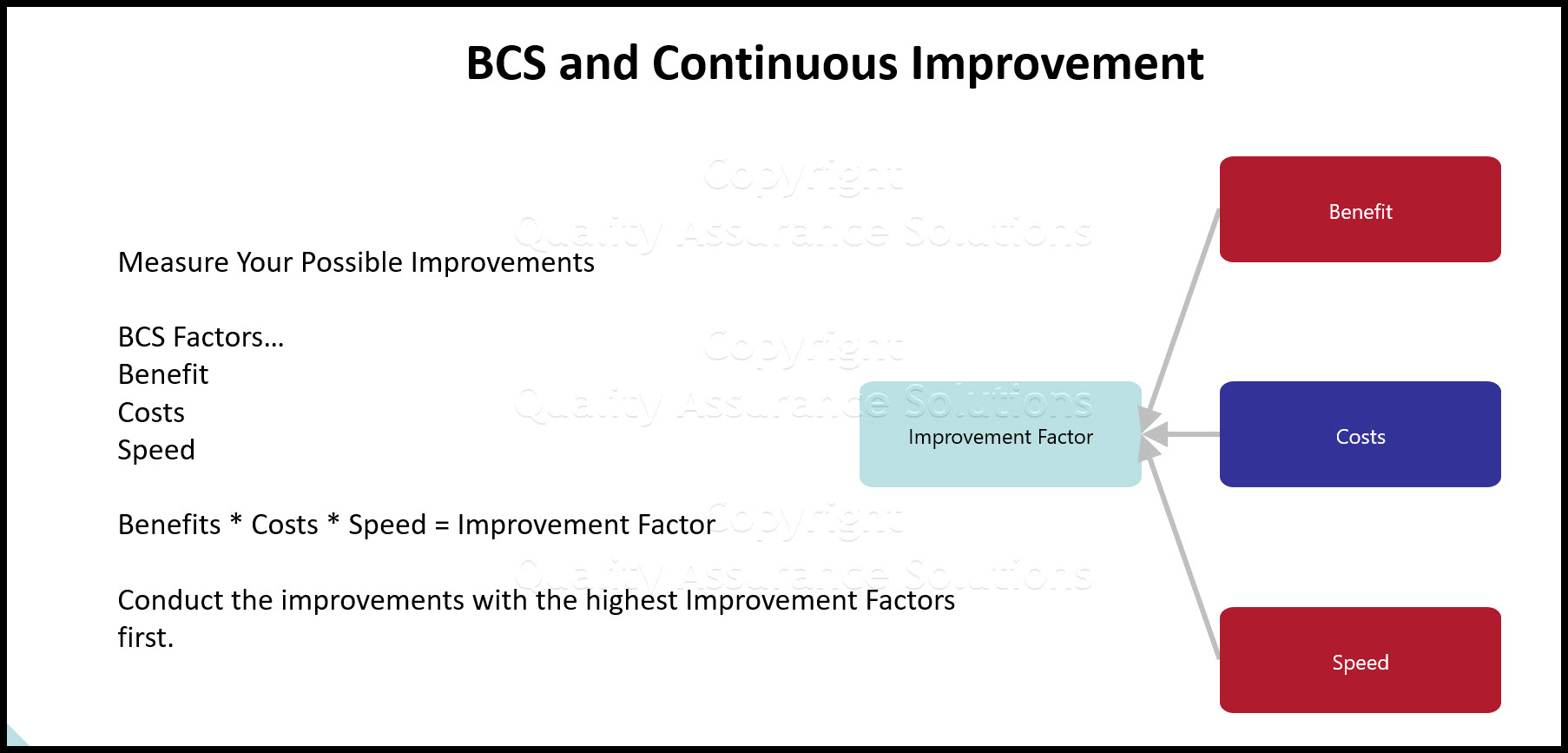Determining
Continuous Improvement
Smart Goals
With
BCS
Continuous Improvement. It's a phrase that every business talks about. We heralded as the way forward for all businesses, especially when it actively engages our staff as we transform our businesses to better serve our customers.
For many businesses generating the improvement ideas can be a real challenge. This is often the focus of many articles.
But what about the other side of the coin? What about when you have too many ideas and you're overloaded with opportunities to change how your organization delivers value to its stakeholders and customers? In this case during our continuous improvement planning process we must create continuous improvement smart goals.
No Method Chaos
Before I suggest a way forward for those who find themselves in this situation, allow me to explain two significant problems with not having a method for dealing with this.
The first one is the 'chase many rabbits catch none' syndrome. You keep changing your mind as to the importance of each action. You don't fully commit to any one course of action and you find yourself going round in circles.
I've been there and I'm sure that you have at some point in time, where the temptation to start everything at once is great. I'm quite impatient and I want all of the changes to take place immediately. Many of my clients feel the same way too, and it can be hard to temper our enthusiasm. As an observation; you can see this on many business plans - the improvement work is front loaded and not staged throughout the year(s).
8D Manager Software with 8D, 9D, 5Y and 4M report generator. Your corrective action software for managing, measuring, and reporting issues.
Managing expectations causes the second problem.
You want your teams to engage in the process of change and you need their ideas. You support, train and coach them to generate ideas. But they still need your help to implement and manage the improvement activity.
They
too get
an overload of ideas, they still need to deal with their day job and
they find themselves with a dilemma of what to work on first. As time
progresses, the team sees a
lack of progress to their contributing ideas. People start to
lose interest in continuous improvement and your efforts become another
well
meaning project that is consigned to the scrap heap. One needs to use continuous improvement smart goals to get your grip around them.
BCS - Continuous Improvement Smart Goals
So, let me share with you a way to avoid this situation.
One way to get out of this situation is to be as objective as possible about each presented improvement idea. If you're a fan of the Pareto principle you will agree that not every idea will be of equal value.
Put simply, you can quickly implement some ideas that deliver a massive benefit. On the flip side, some difficult to implement ideas provide only minimal gains. When you evaluate newly presented ideas you effectively eliminate the two issues that I raised earlier; you easily prioritize your efforts and show visibility of progress.
The acronym that I use with this type of evaluation is BCS, which stands for Benefit, Cost and Speed. A great improvement will:
- Be of great benefit to the business.
- Cost very little.
- Be quick to implement. (Speed)
To use the BCS idea you only need to add three columns to the end of your list of improvement ideas. For each idea you score it in term of the three factors I mentioned above. The scoring works as follows:
Benefit:
- 10 = huge benefit and alignment with business objectives.
- 1 = negligible benefits and / or relevance to the business' goals.
Cost:
- 10 = practically free.
- 1 = capital expenditure proposal required with poor payback period.
Speed:
- 10 = it can happen today!
- 1 = it will take a long time to matriculate through the various departments and committees to get signed off.
(Note - you can choose any numbers between 1 and 10, the above descriptions are to indicate each end of the spectrum)
To calculate the BCS score you simply multiply the three numbers together, to get a value between 1 and 1000. Ranking the scores from height to low now gives you a clear priority list. This creates the best sequence of improvement activity for the business.
Whilst the BCS approach isn't 100% objective, it can provide a framework for you to develop continuous improvement smart goals, with guidelines as clear as you need them to be.
BCS Parameters
In order to improve continuous improvement smart goals you should standardize the BCS Parameters.This lets the team quickly determine the rating for each BCS and minimizes the arguing between team members. In addition when set, the team then understands the score for each item.
QAS Business Slides lets you quickly train your staff in many business disciplines. It includes over 450 editable slides with built-in reference links.
You can use or modify the below.
| Benefit | Customer Growth / Monetary Payback |
| 10 | 50% Growth in a year |
| 9 | 25% Growth in a year |
| 8 | 10% Growth in a Year |
| 7 | 1 day payback |
| 6 | 1 week payback |
| 5 | 1 month payback |
| 4 | 1 year payback |
| 3 | 2 years |
| 2 | 5 years |
| 1 | Unknown |
| Cost | Dollars |
| 10 | Free |
| 9 | $20 |
| 8 | $100 |
| 7 | $200 |
| 6 | $500 |
| 5 | $1000 |
| 4 | $2000 |
| 3 | $5000 |
| 2 | >$5000 |
| 1 | Unknown |
| Speed | Implementation Time |
| 10 | 1 hour |
| 9 | 1 Day |
| 8 | 1 Week |
| 7 | 1 Month |
| 6 | 3 Months |
| 5 | 6 Months |
| 4 | 1 Year |
| 3 | 2 Years |
| 2 | 5 Years |
| 1 | Unknown |
Engagement
Sharing this approach of continuous improvement smart goals with your teams can really benefit your continuous improvement activities too. If they know how you score the improvements they can make a decision as to whether they need to work on their ideas further (to improve the BCS score) or submit them.
By sharing with them the 'leader board' they can also see how their idea fares in the great scheme of things. It isn't lost and its' position in the queue becomes clear. This aids communication and keep enthusiasm for the improvement process alive.
A little twist to this idea, that really improves your team's engagement with continuous improvement smart goals, is the notion of a 'shelf life'.
Let's imagine that you have a list of fifty continuous improvement smart goals with the top seven being currently worked on. In our imaginary list, at position fourteen is a pretty good idea with reasonable benefits and is quick to implement. It hasn't reached the top yet because of its BCS score, and may well get leapfrogged in due course. The person who suggested it can see it sitting there, and it may have been sitting there for a while. What if we chose to give the idea a shelf life, and when it hits this time you decide to do it now anyway? It keeps the list flowing, it keeps the benefits flowing and it communicates to the business that their ideas are important (all of them!).
8D Manager Software with 8D, 9D, 5Y and 4M report generator. Your corrective action software for managing, measuring, and reporting issues.
The same can also be said of ideas that don't make the top of the list and difficult to take action like the example given above. If you set a minimum BCS score for inclusion on the list then you make it clear to the business about what you can handle via continuous improvement smart goals and what it cannot. This approach is no different to your contract review process, where you only accept the work that you can do and make a profit on. Again, having an entry level BCS score can improve the communication and transparency of your continuous improvement approach.
If your business bares a difficult time managing a plethora of improvement opportunities, then you risk of people losing interest due to a perceived lack of progress. Please consider the BCS approach and see if you can re-vitalize continuous improvement at your place of work.
Article written by Giles Johnston of Smartspeed Consulting Limited for Quality Assurance Solutions. Article edited and posted by Quality Assurance Solutions
- QAS Home
- Continuous Improvement Smart Goals
|
Quality Assurance Solutions Robert Broughton (805) 419-3344 USA |
 |
|
Software, Videos, Manuals, On-Line Certifications | ||
|
450+ Editable Slides with support links | ||
|
Corrective Action Software | ||
|
Plan and Track Training | ||
|
AQL Inspection Software |
|
Learn and Train TRIZ | ||
|
Editable Template | ||
|
Templates, Guides, QA Manual, Audit Checklists | ||
|
EMS Manual, Procedures, Forms, Examples, Audits, Videos | ||
|
On-Line Accredited Certifications Six Sigma, Risk Management, SCRUM | ||
|
Software, Videos, Manuals, On-Line Certifications |


























